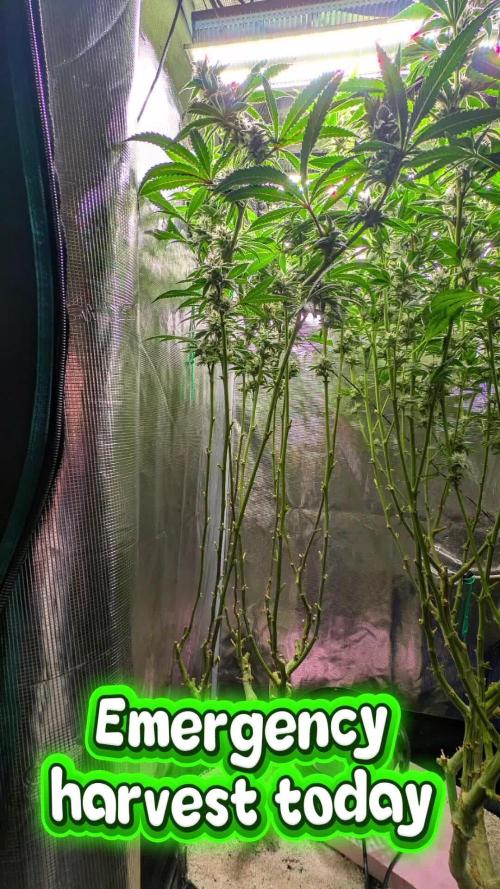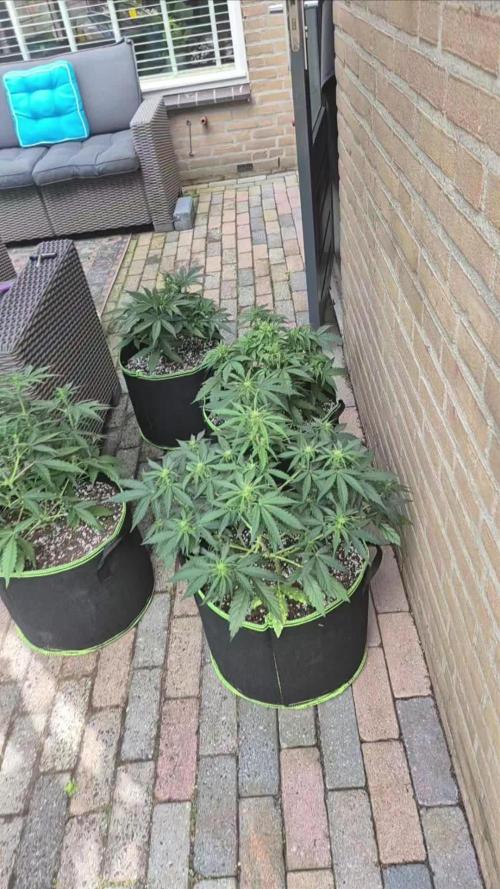The Grow Awards 2026 🏆 

































Likes
Comments
Share


@bobtheblob
Follow
Felt greedy and moved SBR back, they're together again, started one more plant, planning to add another diary soon. Girls look good! Already started blooming, stigmas appeared at the beginning of week 2, buds seem to start forming. Since SBR is a bit smaller than KE she has a podium to stand on. Like a queen ahah. I've cut 2 lower branches of KE, and few from SBR. Not sure about defoliation at the moment, Leaves under the lights seem to be ventilated well and aren't wet
Likes
5
Share


@GrowFunMD
Follow
Look at Cobbler Crisp!!! Day 79 today. Showing out!!! It ha been 11 full weeks. Today is day 1 of Week 12. I will harvest the larger two tomorrow (Friday) and I think the smaller two can go at least another week. Beautiful Plant!
Likes
6
Share


@AutoCrazy
Follow
Week 4 of flower.
5.8-6.0 pH
450ppm
65-68 F water temp.
72 F tent temp
So… the back two plants aren’t stacking like I had hoped. They may end up being popcorn queens. But they are nice and frosty so a long as they produce decent compact and frosty buds I’ll be happy.
The front two are finally bursting into flower. The Mimosa X Orange Punch (front right) is looking good and it smells really unique already. I hope she stacks up some nice buds.
Likes
242
Share


@yan420
Follow
Weekly update for Fantasy Feast #5 — and unfortunately, it’s her last one.
The powdery mildew never fully left this pheno, even after airflow adjustments and leaf removal. To protect the rest of the tent, I made the call to remove her today.
This update covers:
• What the mildew looked like this week
• Why I decided on an emergency harvest
• How I removed the plant safely
• What parts are salvageable and what gets thrown away
• How the rest of the tent is doing after the removal
Rest of grow information in week 33
Likes
17
Share


@Korinthius
Follow
Well, everything appears to be going pretty well. She has stopped growing in height, and the buds are filling out fabulously. her main cola is just gorgeous. I can easily hide a bottle of neuts behind it now. And tons of smaller, but nice tight colas as well.
Her next week begins her flush. According to her genetics, she is 70 days from seed to harvest, and that is only 8 days away. I started germination shortly after midnight on the 1st of oct, and we had taproot within 18hrs. Her Trichromes are starting to become milky, but definately no ambers yet. Have not been able to find much info on other people whom have grown her so it will be a learning experience.
Also according to what little I have been able to find, I should be happy with an ounce to an ounce and a half. I dont know why, but I get the feeling I am getting a bit more than that. Fingers crossed. Could just be my lack of knowledge saying that.
Likes
220
Share


@CRiSPrGrow
Follow
Week 1 : Six Shooter Biotabs
running 3 six shooters one of them is in the biotabs line up, so far very easy although you do have to prepare a bunch of stuff, for the next four weeks it's nothing else so there's that which i nice. Basically, mixed everything acording to the label, i think i didnt add enough orgatrex but hopefully that's fine, just been struggling to keep the seedlings at the right humidity so i've been spraying them. Since i had the boom boom spray i decided to use it, and since i had so much of it left i decided to keep using it as a humidifier. so basically the seedlings oscillate from 20°C and 66RH to 23 and 63RH. giving a vpd of 0,5 to 1.1 depending on the wetness of the medium. the biotabs strains are all moist not wet (like the other pots) after one day , going to let it dry out then 2 more L per biotabs pot basically. i wonder how this little thing can grow into a plant sometimes 😂 that's it 🚀 Was a bit worried about this on as it really didnt like the wet medium and overwatering, doing much better now, main thing is don't panic and don't water before the medium is actually dry. 🚀
Likes
7
Share


@FrostyFarmers
Follow
Since this week is the first with 3 plants in inside the tent and Amnesia 2 has an urgend light stress problem, she switches places with Amnesia 1. We also thought of some new intuitiv names for the plants.
The new order and names are now:
Long Girl (Amnesia 2) - right side
Middleman (Amnesia 1) - middle
The Dwarf (Amnesia 3) - left side
Even though Long Man doesnt look as happy leafe-wise, the problem got a little better with not as many neawly infected ones.
Unluckily she doesnt have as many leaves anymore and the buds at the top look a little naked. Never the less bud growth looks the best out of all plants we think, which is suprising.
Middlemans leafs turnt a little yellow-ish, so she got some more nutrigen-rich fertilizer. This helped already, with new growth having a darker green. Great news. She looks good and healthy overall. Buds looks nice aswell.
Dwarf plant is kinda just existing. It seems like she is just happy in life and doesnt have as high standards. Growth is not as fast, but she also doesnt really do any work, which is fine.
Buds on all 3 plants are very sticky and have a great aroma already.
Likes
9
Share


@Rizik86
Follow
330 grams dry from my first plant is epic! I couldnt be happier! This whole experience has been so much fun! Cant wait to get started on #2 !
Likes
32
Share


@Esoteric_growing
Follow
Flushing nicely, leaves turning yellow and purple. 7 days from now it will be hung and dried
Likes
20
Share


@WeEdandGrowLover
Follow
The lil Big Bud is still growing really well😎.
I started to add master grower massive bloom from hydropassion since day 45.(0.3gr/L).
She really starts to smell good😊.
Likes
31
Share


@HomeGrowBro
Follow
🌱First Grow🌱
🗓️04/03/2022
Hye. So.. this week I see some more trichomes developing. The buds are looking more frosty. If I go real close I can smell a pine/lemon smell. I harvested the Marigold Bush. I wanted to preserve the flower instead of them rotting away. Found some interesting bugs.. check them out. I am using a bottle with water and wik to create some more humidity.
Thanks for reading.
🌍 Weather:☀️☀️☀️☁️🌧️☁️🌤️
🌱Nutrients:
Fish tank water as nutrients: (K)
Bounce Back: (N)(P)(K)(Ca)(S)(Mg)
Telborne Organics: 3:1:5(18) (N)(Ca)(Na)(Fe)(B)(P)
Likes
9
Share


@Staffedition
Follow
Привет друзья.
Наше знакомства продолжается с новым сортом автоцветущих растений от Smail_Seeds сорт ORIGINAL AUTO CHEMZKITTLEZ F1 reg.
Сегодня растению 97 дня.
Шишки налились очень хорошо😀
Вы всё сами видите.
Скоро будут феминизированные
Сорт выводим сами.
Смотри мой профиль, у нас всегда есть что то интересное.
Не забудь поставить лайк❤️, если понравилась как прошла неделя
И читайте наш TELEGRAM: https://t.me/smail_seeds
#Smail_Seeds 😀
Likes
Comments
Share


@mihixd
Follow
2 plants have finished stretching while the 2 small ones are still in veg? vegging plants are ~40cm, biggest plant 75cm😄
D29
2L bottomwatering, last time i defoliate the plants for at least one week.
D32
mix or top and bottomwatering 5L per plant. 2 blooming plants got calmag+bloom, vegging plants got calmag+grow+pr
I definitely overwatered today a bit, but the plants handled it fine.
D34
Placed a new light above them. 600W from
Likes
7
Share


@TheGreenLeopard
Follow
big strong auto, wish i had more space for it. its showing promise .. bud transition started this week. nutrients i find it tough to decide on auto but should be fine .. thanks for visiting.
Likes
16
Share


@Samsemilla
Follow
Die fünfte Woche startet mit einer (Teil-)Entlaubung, das Blätterdach ist wieder sehr dicht gewachsen.
Die Blätter bekommen wieder ein satteres grün.
Irgendwann innerhalb der nächsten Wochen sollten sie ihr Geschlecht zu erkennen geben, noch sind sie etwas schüchtern.
Ich sehe die ersten Anzeichen, kann es aber noch nicht klar deuten - abwarten und Tee trinken.
Ich habe dem Wassertank meines Autopot Systems einen Luftstein hinzugefügt.
Wird das einen großen Effekt bringen? - keine Ahnung.
Kann es schaden? - ich denke nicht.
So langsam zeigen sich die ersten weiblichen Vorblüten, ich kann aber noch nicht bei allen 13 Pflanzen mit Sicherheit das Geschlecht bestimmen.
Likes
27
Share


@adam_pawloski87
Follow
Let’s go day 43!!!! Week went real well , girls started preflower so sometime this week I will be switching up the nutrients for flowering! We are stable and looking super healthy! Can’t wait to see what these ladies do this week! Hope you all enjoy !
Likes
16
Share

@Shawneyboy85
Follow
This week has been good, no surprises the pistols are really starting to show in the Zkittles and the Cheese is next is going to be next. The Lemon pie is a little bit behind in this round but I have another that’s 2 weeks younger and twice the height. Did some defoliantion a day or two ago everything seems to be happy























